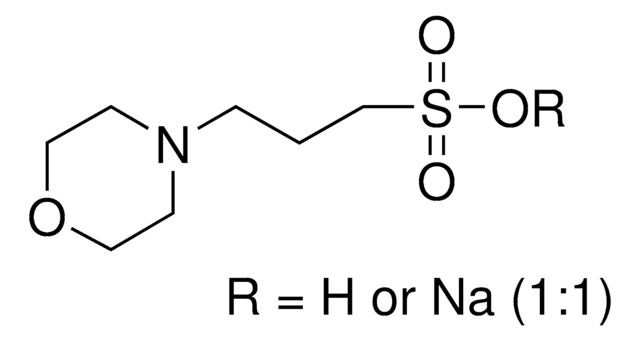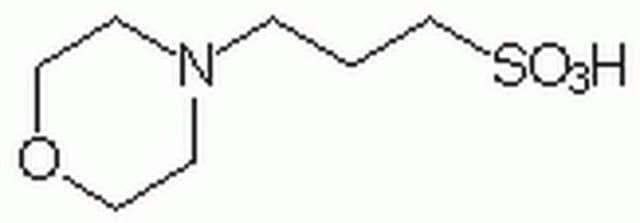M3183
MOPS
≥99.5% (titration), crystalline powder, BioPerformance Certified, suitable for cell culture
Synonym(s):
3-(N-Morpholino)propanesulfonic acid, 4-Morpholinepropanesulfonic acid
About This Item
product name
MOPS, BioPerformance Certified, suitable for cell culture, ≥99.5% (titration)
grade
BioPerformance Certified
Quality Level
Assay
≥99.5% (titration)
form
crystalline powder
technique(s)
cell culture | mammalian: suitable
impurities
endotoxin and TAMC, tested
pH
2.5-4 (25 °C, 209 g/L)
useful pH range
6.5-7.9
pKa (25 °C)
7.2
cation traces
Fe: ≤5 ppm
λ
33 % in H2O
application(s)
diagnostic assay manufacturing
foreign activity
DNase, RNase, protease, none detected
SMILES string
OS(=O)(=O)CCCN1CCOCC1
InChI
1S/C7H15NO4S/c9-13(10,11)7-1-2-8-3-5-12-6-4-8/h1-7H2,(H,9,10,11)
InChI key
DVLFYONBTKHTER-UHFFFAOYSA-N
Looking for similar products? Visit Product Comparison Guide
Application
- A production platform for disulfide-bonded peptides in the periplasm of Escherichia coli.: This research developed a novel platform for producing disulfide-bonded peptides in E. coli, using MOPS buffer to maintain a stable pH environment essential for protein folding and stability in the periplasmic space. The platform could significantly enhance the production of therapeutically relevant peptides (Gibisch et al., 2024).
Packaging
Each kit contains 3 x 100G samples, each sample from a uniquely manufactured lot.
Other Notes
Storage Class Code
13 - Non Combustible Solids
WGK
WGK 1
Flash Point(F)
230.0 °F - closed cup
Flash Point(C)
110 °C - closed cup
Personal Protective Equipment
Certificates of Analysis (COA)
Search for Certificates of Analysis (COA) by entering the products Lot/Batch Number. Lot and Batch Numbers can be found on a product’s label following the words ‘Lot’ or ‘Batch’.
Already Own This Product?
Find documentation for the products that you have recently purchased in the Document Library.
Customers Also Viewed
Our team of scientists has experience in all areas of research including Life Science, Material Science, Chemical Synthesis, Chromatography, Analytical and many others.
Contact Technical Service



